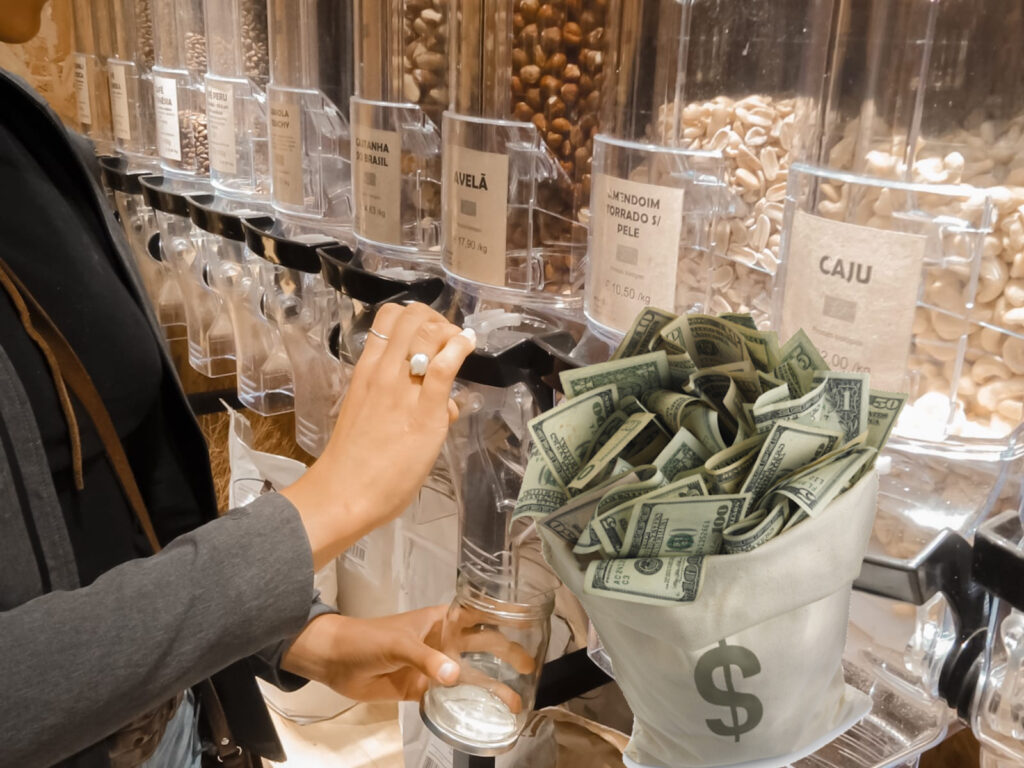Are you one of those afraid of switching to zero waste because it seems expensive to buy everything in bulk from local and organic retailers? You are not alone. But how to live zero waste on a budget ? Read more here about why zero waste is cheap:
How to live zero waste on a budget?
But being zero waste actually pays out in the long term, and if it is more expensive than your previous lifestyle, you are doing it wrong. Why? Because those fancy, expensive glass containers, bamboo take-away cutlery sets and waterproof sandwich bags are all nice and cool, but useless and reinforce the same consumerism you are trying to avoid by becoming zero waste. Isn’t it easier to grab some fork and knife from your drawer and use the jars you already have in mountains in the back of the cupboard after those peanut butter and jam bagels? You can as well just use one of those food containers from your cupboards.
So, why would it be expensive to go zero waste?
Seeing zero waste on Instagram and TikTok isn’t about becoming eco-friendly, more sustainable, and waste-free. The zero waste you see on social media usually tries to sell you more and more new things, based on your interest in sustainability or zero waste. That is all okay, but buying these ‘zero waste’ products, like new bamboo container make up, your number 23 tote bag, another fancy glass jar just because you don’t yet have this exact shape or size or the other ones still have their original labels on in your cupboard, or a new wooden kitchen tool, because the plastic one you had for years doesn’t align with the eco-friendly image you’re trying to create.
There is no problem with this, but this is not zero waste. It’s rather a twisted side of minimalism, where the point is how the things you have around look. Not their usefulness and their potential to be reused again and again. This is where zero waste turns into being more expensive, because stylish minimalism is, indeed, expensive.
On the other hand, zero waste – if done right for the actual purpose of cutting waste – is not expensive. That is because if you see the creative new life of your stuff in your home, you can use them instead of buying useless new stuff. You can keep using that deodorant and toothbrush, and switch to that safety razor only when you run out those plastic ones. Sure, there will be some costs. But these would be there anyway, if you live non-zero waste as well. Still, paying a bit more step-by-step when you really need to, for products you will use for years instead of days or weeks pays out in the long-term. And that is where zero waste becomes cheaper than normal consumerism.
Change your mentality about costs
Focus on the long-term financial benefits. Sure, a safety razor is not as cheap as a single-use plastic one. But 2 packs of single-use razors pay you a safety razor, and you will use it 10 times longer than those 2 packs of single-use razors. Single-use plastic mineral water is cheap, I know. But buying 30 bottles (that’s just under a month you’d buy) equals to buying a ‘fancy’ Chilly’s bottle that you can refill almost anywhere – including airports beyond the security check. Although, that one time when you buy that bottle it seems expensive, of course. But in the long-term, you save much more by not buying those plastic bottle waters anymore.
And how can it be cheap to go zero waste?
Instead of impulsively buying anything that is labelled as zero waste, go around your house and think creatively, what can you use as a replacement of something in your home, that is plastic-wrapped. For example, how can that pesto jar turn into a spice jar for bulk spices? You can decorate or label your existing jars, they don’t need to be like a perfect cutlery set where all the spoons are the same shape, colour, size and brand. Your rice doesn’t need the exact same container as your ground black pepper, right?
Again, this is a process of mental switching from the social media-zero waste to the actual zero waste. Instead of scrolling through those Instagram posts, reels and TikTok videos that try to sell you the perfect-looking ‘zero waste’ home, think creatively, how can you reuse what you have, to be able to reduce your (plastic) waste.
Once you found your containers at home, you will realise, bulk stuff is way below the supermarket prices. So, again, zero waste is cheaper. A few examples:
Why buying plasticfree food in bulk is cheaper
| packaged price | bulk price (Little Plant Pantry) | |
| wholegrain organic penne 500 g | € 2.56 (Jumbo) | € 1.95 |
| Organic brown basmati rice 400 g | € 2.39 (Albert Heijn) | € 2.08 |
Conclusion: zero waste is cheap
Social media zero waste can be expensive, but true zero waste does not need to be. Be creative, see beyond the image about zero waste created by social media and think in the long-term when it comes to costs. This is the way forward in seeing how zero waste is actually cheaper, when you sum up the reusable tools and the bulk prices together.
So, shoo your doubts away, and focus on what matters to you: a sustainable, plastic- and waste-free living, to protect your environment and your and your children’s future. Start your journey towards becoming zero waste today, in an affordable and creative way!

